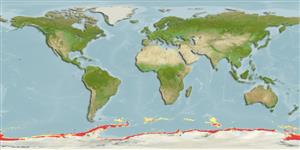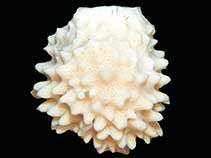Rossella racovitzae Topsent, 1901
| Native range | All suitable habitat | Point map | Year 2050 |

|
| This map was computer-generated and has not yet been reviewed. |
| Rossella racovitzae AquaMaps Data sources: GBIF OBIS |
Classification / Names Common names | Synonyms | CoL | ITIS | WoRMS
Hexactinellida | Lyssacinosida | Rossellidae
Environment: milieu / climate zone / depth range / distribution range Ecology
Sessile; depth range 18 - 2000 m (Ref. 89939). Polar
Distribution Countries | FAO areas | Ecosystems | Occurrences | Introductions
Antarctic.
Length at first maturity / Size / Weight / Age
Maturity: Lm ? range ? - ? cm
Short description Morphology
Life cycle and mating behavior Maturity | Reproduction | Spawning | Eggs | Fecundity | Larvae
Main reference
References | Coordinator | Collaborators
Andrew, N. and M. Francis 2003 The living reef. The ecology of New Zealand's rocky reefs. Craig Potton Publishing, New Zealand. 283pp. (Ref. 82739)
IUCN Red List Status
(Ref. 130435: Version 2025-1)
CITES status (Ref. 108899)
CMS (Ref. 116361)
Threat to humans
Human uses
| FishSource |
Tools
More information
Max. ages / sizes
Length-weight rel.
Length-length rel.
Length-frequencies
Mass conversion
Abundance
Internet sources
BHL | BOLD Systems | CISTI | DiscoverLife | FAO(Publication : search) | Fishipedia | GenBank (genome, nucleotide) | GloBI | Gomexsi | Google Books | Google Scholar | Google | PubMed | Tree of Life | Wikipedia (Go, Search) | Zoological Record



